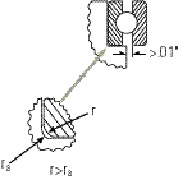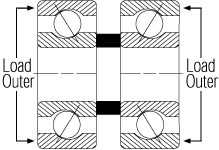| Available Bearings | Bearing Selector | Technical Info | New Products | |||
Bearing Mounting and Fitting: Shoulder Design || Dynaroll Bearing Design Factors Part 2
TECHNICAL PAPERS
Inch Precision
Metric Precision
600 Series
6000 Series
6200 Series
6300 Series
6800 Series
6900 Series
R Series
Thrust Bearings
Stainless Steel Thrust Bearings
Thin Section Bearings
Collar Bearings
Flangette Collar Bearings
Specify by Type
Specify by Desired Dimensions
Specify by Cross-Reference
Specify by Known Part Number
Part Numbering System
TECHNICAL PAPERS
DESIGN FACTORS WHEN USING SMALL BEARINGS, PART 2: MOUNTING AND FITTING (Page 5)
| Shoulder Design
When a bearing is located against a shoulder in a mating part, care must be taken that the rim of the shoulder clears the opposing ring. This is achieved when the diameter of the shoulder has clearance over the opposing race land diameter. Maximum shaft shoulder diameter = Outer
ring land diameter – Clearance*
Preload Assembly Methods Preload is the force applied between
the races of a pair of bearings to remove the axial play and to
further compress the bearings to provide both axial and radial
stiffness. It is an important design parameter, affecting rotational
performance and lifetime of a bearing assembly. After preload,
the resulting ball contact angle a must be considered (see Part
I – Bearing Geometry).
|




